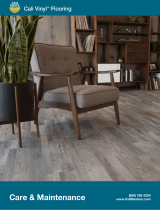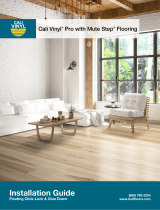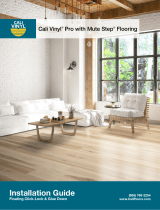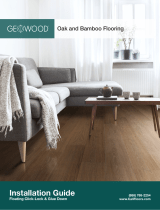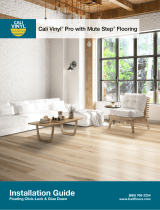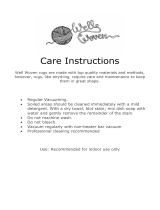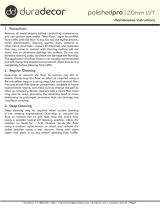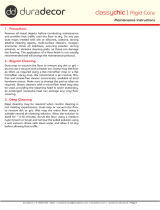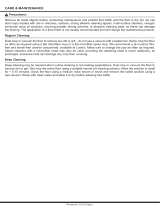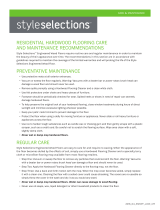Page is loading ...

Odyssey
Care & Maintenance
(888) 788-2254
www.CaliBrands.com
Engineered Hardwood Flooring

Questions? (888) 788-2254
www.CaliBrands.com
Odyssey Flooring Care & Maintenance
Care & Maintenance
Routine Cleaning
Clean the floor with WOCA Natural Soap and warm water using a damp mop up to once a week. Routine cleaning with
WOCA Natural Soap is an essential part of maintaining the floor’s finish. Failure to properly maintain the floor will void
the warranty.
Natural Soap White is recommended for light wood species, while Natural Soap Natural is ideal for dark wood. The
solution cleans the floor, strengthens the finish, and increases water resistance. The cleaning agents are emollients
extracted from soy beans and coconut oil, which clean the floor and also retain moisture in the floor (just as quality
soap would for your hands). As the emollients dry and form an invisible film on the surface, the floor receives added
protection against wear and dirt.
To clean the floor, you’ll need the Natural Soap, two buckets, and a cotton mop. Do not use a micro-fiber mop on the
floor.
• Shake the Natural Soap carefully before use
• To make the cleaning solution, mix a ¼ cup of Natural Soap per gallon of lukewarm water.
• Work with 2 buckets: one with soapy water and one with rinse water.
• Clean the floor with as little water as possible. Always use a wrung-out mop to wipe the floor with soapy water in
order to re-establish the protective Natural Soap film. Leave soapy water on the floor briefly to dissolve dirt.
• Remove dirty soapy water with a hard wrung-out mop and rinse out in bucket of rinse water. The moisture from the
dampened mop should evaporate off the floor very quickly.
Never use a steam mop or wet-mop as standing water may cause permanent damage. Excessive moisture will dull the
finish and could lead to a cupped floor.
WOCA Natural Soap can be purchased online: https://www.wocadirect.com/natural-soap/
Spot Cleaning
For spot cleaning, use WOCA Natural Soap Spray or Natural Soap White Spray which is premixed soap and water.
WOCA Natural Soap Spray can be purchased online: https://www.wocadirect.com/natural-soap/
Refreshing
WOCA Oil Refresher should be used for regular cleaning and maintenance of oiled wood floors. Refresh the floor with
WOCA Oil Refresher two to four times a year.
Oil Refresher Natural is typically used for natural oiled and color oiled floors and Oil Refresher White is for white oiled
wood. Oil Refresher combines efficient cleaning with simultaneous re-oiling. The oil penetrates into the wood and
provides the surface with a protective matte film. The use of Oil Refresher will extend the life of the oil finish and is
an essential part of maintaining the Floor. Failure to properly maintain the floor with will void the warranty.
To refresh the floor, you’ll need the Oil Refresher Natural, two buckets, and a cotton mop. Do not use a micro-fiber
mop on the floor.
1. Ensure that all dust and debris is removed from the floor.
2. Shake the bottle of Oil Refresher well before use.
3. To make the refresher solution, mix 3/8 cup of WOCA Oil Refresher per gallon of water.
4. Work with 2 buckets: one the refresher solution and one with rinse water.
5. It is recommended to clean an area of approximately 50 square feet at a time. By doing it this way, the floor is only
exposed to moisture for a short period.
6. Dip the mop into the mixture and with the well wrung mop wipe lengthwise on the wood. Then clean the mop head
in the rinse water, wring very well, and continue until the whole floor is cleaned.
7. Leave the floor to dry for approximately two hours before use.
So as not to develop unwanted oil buildup, it is recommended that cleaning with WOCA Soap and Oil Refresher be
alternated so that Oil Refresher is not used more than four times a year.
WOCA Oil Refresher can be purchased online: https://www.wocadirect.com/oil-refresher/

Questions? (888) 788-2254
www.CaliBrands.com
Odyssey Flooring Care & Maintenance
Care & Maintenance
General Care
• Avoid excessive moisture on the floor. We recommend soaking up spills immediately using a dry cotton towel or
dry mop (do not use microfiber). For flooring in the kitchen, place an area rug in front of the kitchen sink.
• Cali Hardwoods floors, like all species of hardwood flooring, are subject to changes in temperature and humidity.
As a general rule, flooring will perform best when the interior environment is controlled to stay within a relative
humidity range of 30%-55% and a temperature range of 60° to 80° Fahrenheit. Seasonal fluctuations in relative
humidity may cause the wood flooring to gain moisture with periods of high humidity and lose moisture during low
periods of humidity. During warm, humid weather, wood expands and during dry weather, wood contracts. These
changes may be noticeable but can be minimized by using an HVAC system to maintain relative humidity between
30%-55%. This seasonal movement is a normal characteristic of wood flooring and is not considered a defect. It
is the owner’s responsibility to maintain appropriate conditions via the use of a humidifier and/or de-humidifier.
Ventilation, humidity, and temperature control is a must even when the home is not occupied.
• To clean up dried glue use either Bostik Ultimate Adhesive Remover or Titebond Adhesive Remover cleaning
wipes.
Preventative Care
• Vacuum or sweep the floor with a broom or dust mop on a regular basis or as needed to remove dirt, sand, or
grit to protect the floor from scratches. A grain of sand has dozens of sharp edges and can create scratches if
tracked across the floor. Be careful of other debris such as small rocks and pebbles being drug across the floor.
• Do not use vacuums that use a beater bar or turn beater bar off; brush or felt vacuum heads are recommended as
opposed to hard heads.
• Fit furniture legs with felt tips and fix rolling furniture with soft rubber casters to avoid scratches. Periodically
check the felt tips for wear or buildup of grit/debris and replace as needed.
• Pick up heavy furniture or appliances; do not slide.
• Keep pet nails trimmed to avoid excessive scratching.
• To prevent dents and scratches, avoid walking on the floor with cleats, sports shoes, and high heels. High heels
concentrate pressure in a small area and may dent the floor.
• To prevent indentations and scratches remove small diameter buttons/ends from furniture legs and replace with
non-staining floor protectors with a surface no less than 1” in diameter. Heavier objects may require wider floor
protectors.
• Use interior and exterior doormats at entrances to prevent dirt and moisture from being tracked onto the floor.
Area rugs are also recommended in front of kitchen sinks and in high traffic areas. Rugs must be made of a
breathable material to prevent moisture entrapment. We recommend using a breathable rug underlay; mesh or grid
patterns are best. Do not use rugs with solid rubber or vinyl backings as this may damage the finish.
• Natural products will change color over time as a result of oxidation and UV rays. This color change is inherent
and not a defect. Limit direct sunlight on the floor by using curtains and blinds in areas that are exposed to high
UV rays. We recommend rearranging rugs and furniture periodically so that the color changes evenly, especially
in the first few months the floor is installed.
• Abrasive or harsh chemicals should not be used to clean the floor. Never use any of the following products on
the floor: mineral spirits, paint thinner, acetone, ammonia-based cleaners, acrylic finishes, wax-based products,
detergents, bleach, polishes, abrasive cleaning soaps, or acidic materials such as vinegar. Never apply wax
treatments to the floor.
• Heating units or non-insulated ductwork close to the flooring or subfloor may cause “hot spots” which must be
eliminated prior to installation.
• Heavy furniture (500+ lbs.) may obstruct the free, natural movement of a floated floor. Restricting this movement in
certain areas can lead to problems such as buckling or separation when the floor experiences natural expansion
and/or contraction. Do not install flooring under permanent or fixed cabinetry and never nail or screw anything
through a floated floor.
• Lighter colors and darker colors naturally show more dirt, flaws, and marks and are considered higher
maintenance.

Questions? (888) 788-2254
www.CaliBrands.com
Odyssey Flooring Care & Maintenance
Care & Maintenance
Frequently Asked Questions
How do I fix a scratch on my finish?
If the scratch is white, the finish has not been compromised and is repairable. Simply spot cleaning the floor with
WOCA Natural Soap Spray, should eliminate these blemishes. Often the damage becomes less obvious. For scratches
that cannot be buffed out, use a CALI Hardwoods touch-up marker.
The wood veneer was damaged through the finish. Can it be repaired?
If you have a minor chip or slight damage, this may be minimized using a CALI Hardwoods touch-up marker and/or
Fil-Stik. CALI Fil-Stiks are wood fill products that work great to reduce the appearance of deeper blemishes. In most
cases, more than one shade may be appropriate. If the damage is severe enough, board replacement is typically the
best option.
How can I remove a stain?
When removing stains from any wood floor, always begin at the outer edge of the stain and work toward the middle.
Can I refinish my CALI Flooring?
Major modifications are not recommended and are never a guaranteed solution; all repairs are unique. Nevertheless,
it is possible to refinish or recoat the 1 time. Always seek assistance from an NWFA Certified Installer, and always test
on a sample plank before you proceed. Refinished or recoated floors are not covered under warranty.
Occasional Flooring Noise
Floor noise is normal and will vary from one installation type to the next. Occasional noise is due to structural
movement and may relate to sub-floor type, flatness, deflection, and/or related to the fasteners, changes in
environmental conditions, relative humidity and the amount of topside pressure applied to the flooring. For these
reasons floor noise is not considered a product or manufacturer defect.
/


